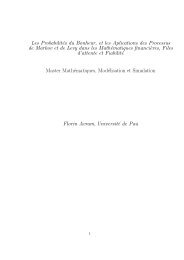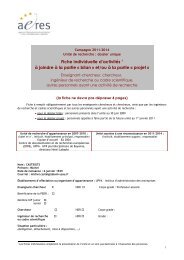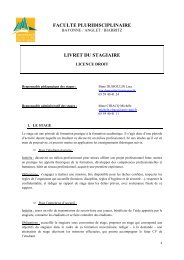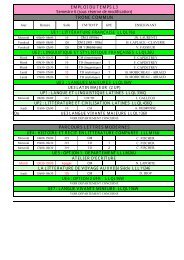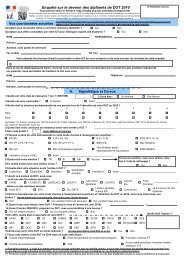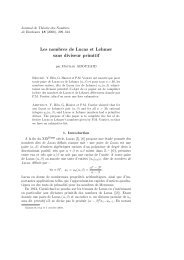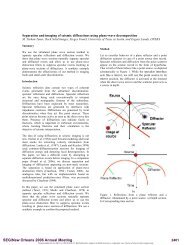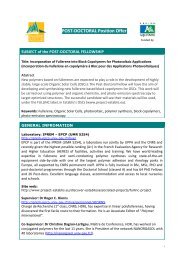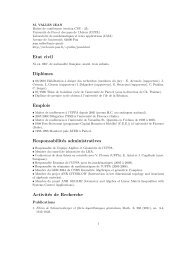Processus de Markov, de Levy, Files d'attente, Actuariat et Fiabilité ...
Processus de Markov, de Levy, Files d'attente, Actuariat et Fiabilité ...
Processus de Markov, de Levy, Files d'attente, Actuariat et Fiabilité ...
Create successful ePaper yourself
Turn your PDF publications into a flip-book with our unique Google optimized e-Paper software.
FILES D’ATTENTE, FIABILITÉ, ACTUARIAT<br />
où t p (x) est une solution particulière <strong>et</strong> h(x) est la solution générale <strong>de</strong> l’équation<br />
homogène. Commençons par l’équation homogène.<br />
La solution générale homogène (”fonction harmonique”) h(x) = A + Bx pour c<strong>et</strong><br />
opérateur a été déjà obtenue ci-<strong>de</strong>ssus.<br />
Nous aimerions maintenant trouver une solution particulière t p (x) <strong>de</strong> l’équation Gt p (x) =<br />
−1 <strong>de</strong> la même forme que la partie nonhomogène −1 <strong>de</strong> l’équation, donc t p (x) = C;<br />
mais, comme les constantes, <strong>et</strong> puis aussi les fonctions linéaires vérifient l’équation<br />
homogène Gt p (x) = 0, nous <strong>de</strong>vrons modifier <strong>de</strong>ux fois c<strong>et</strong>te forme en multipliant par<br />
x, en arrivant donc à t ( x) = Cx 2 . Comme Gx 2 = 2x(p − q) + 1 = 1, on trouve C = −1<br />
<strong>et</strong> finalement la solution particulière t p (x) = −x 2 .<br />
La solution générale est donc t(x) = −x 2 +A+Bx <strong>et</strong> les conditions frontière ramènent<br />
à t x = x(B − x).<br />
Pour p ≠ q<br />
t x = pt x+1 + qt x−1 + 1 for any 1 ≤ x ≤ B − 1<br />
t B = 0<br />
t 0 = 0<br />
La solution generale homogène avec p ≠ q est h(x) = k 1 (q/p) n + k 2 <strong>et</strong> le terme<br />
nonhomogène 1 sugere une solution particulière constante k, mais comme ça satisfait<br />
l’équation homogène, on modifie à kn. Finalement, k = 1 . q−p<br />
La solution particulière est t p (x) = x ; elle satisfait <strong>de</strong>ja t q−p p(0) = 0. La partie homogène<br />
h(x) = t x − t p (x) <strong>de</strong>vra aussi satisfaire h(0) = 0 <strong>et</strong> donc elle sera <strong>de</strong> la forme h(x) =<br />
A˜h(x) où ˜h(x) = ((q/p) x − 1).<br />
En <strong>de</strong>mandant que t n = n + q−p A(q/p)n − 1) satisfait la condition frontière t B = 0 on<br />
trouve :<br />
t n = t p (n) − t p (B) ˜h(n)<br />
˜h(B) =<br />
{<br />
∞<br />
n<br />
q − p −<br />
B (q/p) n − 1<br />
q − p (q/p) B − 1 .<br />
si p > q<br />
La limite quand B → ∞ est t n =<br />
; on peut aussi obtenir ce<br />
t p (n) = n si p < q<br />
q−p<br />
resultat en utilisant l’approximation détérmiste X n − X 0 ∼ nE(Z 1 ), appellée aussi<br />
limite flui<strong>de</strong>.<br />
7. c x = E x [ ∑ T −1<br />
0<br />
X(t)] (coût total d’inventaire ésperé) satisfait le système inhomogène<br />
Gc(x) + x = 0, c(0) = 0, c(B) = 0.<br />
Pour p = q :<br />
c x = c x+1<br />
2 + c x−1<br />
+ x for any 1 ≤ x ≤ B − 1<br />
2<br />
c B = 0<br />
c 0 = 0<br />
Une solution particulière est c p (x) = −x3.<br />
Finalement, on arrive à c(x) = x(B2 −x 2 )<br />
.<br />
3 3<br />
Pour p ≠ q, une solution particulière est c p (x) =<br />
x2 (elle satisfait <strong>de</strong>ja c 2(q−p) p(0) = 0).<br />
La partie homogène satisfaisant h(0) = 0 sera toujours h(x) = A˜h(x) où ˜h(x) =<br />
((q/p) x − 1).



